- But what if that narrative isn’t the only truth?
- This is not a blog about miracles. It’s about mechanisms.
- The Cure They Promised Never Came
- Why ART Can’t Cure HIV: Understanding the Suppression Trap
- The Molecular Mechanism of ART—and Its Limitation
- “ART can silence the alarm, but it can’t disarm the explosives.”
- The ART Paradox: Why You Can’t Stop—Even When You Feel Better
- Why the Cure Remains Elusive in Modern Science
- Understanding the Terrain: Agni, Ama, and Srotas
- Ojas: The Forgotten Dimension of Immunity
- Terrain, Not Pathogen: A Paradigm Shift
- Shodhana – Clearing the Biological Terrain
- How Shodhana Targets Latent HIV Pathology
- Rasayana Therapy- The Main Therapy
- Ayurveda and ART Integration – Can They Work Together?
- Why This Isn’t Mainstream—And Why That Shouldn’t Stop You?
- References
For decades, the global medical community has presented antiretroviral therapy (ART) as the only viable answer to HIV. Patients are taught to expect management, not resolution. Suppression, not eradication. Lifelong dependency, not liberation.
But what if that narrative isn’t the only truth?
What if, long before the discovery of HIV in 1983, a medical science had already outlined the mechanisms of latent pathogens, immune collapse, tissue purification, and full recovery? That science is Ayurveda—an intricate and clinically rich system of medicine born thousands of years ago and documented in detail in classical texts like the Charaka Samhita and Sushruta Samhita.
This is not a blog about miracles. It’s about mechanisms.
At Panaceayur, we believe it’s time to reintroduce this wisdom to the modern world—scientifically, respectfully, and clinically. This article explores why HIV cannot be eradicated with ART, and how Ayurvedic Rasayanas, mineral nanomedicines, and personalized terrain-based therapies offer a real, research-aligned path toward immune regeneration and complete viral elimination
The Cure They Promised Never Came
Since the first clinical cases of AIDS were reported in the early 1980s, the medical establishment has made tremendous progress in managing HIV. Antiretroviral therapy (ART) has transformed what was once a death sentence into a manageable chronic condition. Yet, for millions living with HIV, a quiet but persistent question remains: Why is there still no cure?
Despite decades of pharmaceutical advancements, every HIV patient is told the same story—you must take ART for life. The virus, they say, is too elusive. It hides in reservoirs the drugs can’t reach, and if therapy is ever stopped, it comes roaring back. This narrative, repeated in every clinic and echoed in every brochure, leaves no room for discussion. Suppression is the only goal. Eradication? Out of the question.
For many patients, especially in the West, this reality is emotionally and spiritually exhausting. There’s the daily burden of medications. The anxiety of lab results. The cumulative toxicity. And perhaps most painful of all—the knowledge that even after 10 or 20 years of treatment, the virus still lives on inside their bodies.
But what if this wasn’t the only path? What if there existed another medical framework—one that understood latent diseases, immune collapse, and tissue regeneration long before HIV was discovered? What if the cure the world is waiting for isn’t in the future, but buried in the past?
This is where Ayurveda enters the conversation—not as an alternative, but as an ancient and complete system of medicine with its own language, pharmacology, and clinical protocols. In Ayurvedic terms, HIV is not just a foreign invader to be suppressed. It is a disturbance in the inner terrain, a seed of disease (Beejabhava Dosha) that thrives in the weakened soil of the body’s tissues and channels (Dhatus and Srotas). The goal is not to block the virus—it is to eliminate the conditions that allow it to persist.
At PanaceAyur, we are not offering magical thinking. We are reviving forgotten clinical science—methods documented in the Charaka Samhita, Sushruta Samhita, and other classical Ayurvedic texts, and supported by emerging modern research. We invite readers—especially those feeling trapped by ART—to consider that true healing may require a new lens. Not a fight against HIV, but a restoration of immune intelligence, metabolic fire (Agni), and the subtle essence of vitality known as Ojas.
This is not about rejecting modern medicine. It is about reclaiming the right to complete health—beyond viral suppression, beyond dependency.
Why ART Can’t Cure HIV: Understanding the Suppression Trap
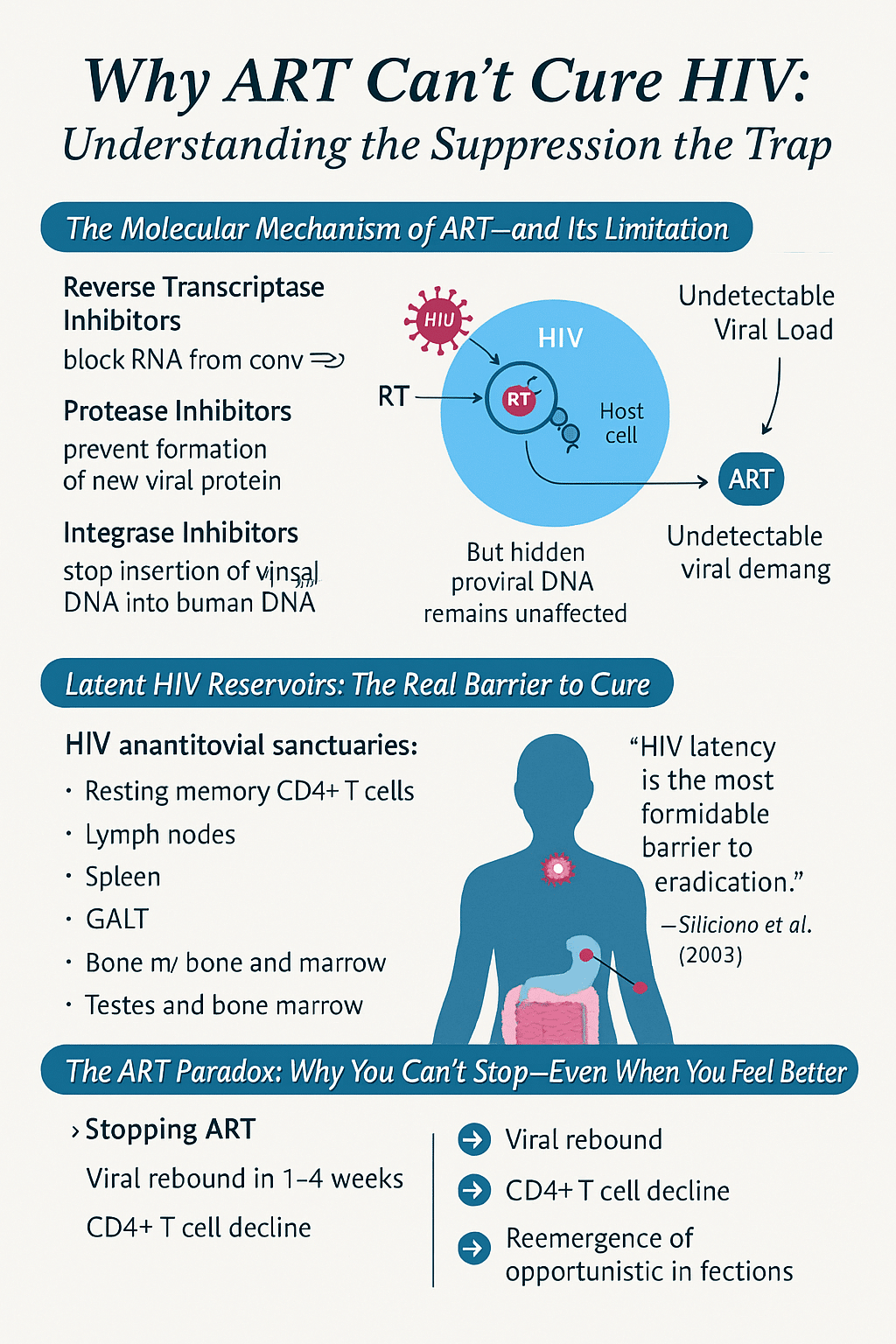
In the realm of modern HIV care, antiretroviral therapy (ART) is often presented as a medical marvel—a treatment that transforms HIV from a fatal disease into a chronic, manageable condition. While ART has indeed extended the lives of millions, it remains fundamentally a strategy of viral suppression, not viral elimination. This distinction is critical and forms the basis for understanding why Ayurveda approaches HIV with a different therapeutic vision: not to control the virus, but to eliminate the conditions that allow it to survive.
The Molecular Mechanism of ART—and Its Limitation
ART works by targeting three key enzymes essential to HIV replication:
- Reverse Transcriptase Inhibitors block the conversion of viral RNA into DNA (e.g., Zidovudine, Lamivudine).
- Integrase Inhibitors (e.g., Dolutegravir) prevent viral DNA from integrating into the host genome.
- Protease Inhibitors (e.g., Ritonavir) inhibit viral protein processing, preventing the creation of mature virions.
These drugs reduce circulating viral particles to undetectable levels in most patients. However, they do not touch the proviral DNA already embedded inside long-lived host cells. That latent viral DNA is transcriptionally silent, shielded from immune surveillance, and unaffected by drug activity. It remains a biological time bomb—silent today, reactive tomorrow.
“ART can silence the alarm, but it can’t disarm the explosives.”
Latent HIV Reservoirs: The Real Barrier to Cure
Within days of infection, HIV establishes reservoirs in specific tissues and cell types. These include:
- Resting Memory CD4+ T Cells: Harbor integrated HIV DNA for years without producing new virions.
- Gut-Associated Lymphoid Tissue (GALT): Contains up to 60% of the body’s total lymphocytes. HIV thrives in mucosal sites.
- Central Nervous System (CNS): Microglia and astrocytes can harbor latent virus; the blood-brain barrier prevents drug penetration.
- Lymph Nodes & Spleen: Immunological hubs where infected cells can persist in follicular dendritic networks.
- Testes and Bone Marrow: Immunologically privileged sites with lower ART access.
These sanctuaries are impervious to antiretrovirals. According to research by Siliciano et al. (2003), even with years of ART, latent reservoirs decay at a half-life of approximately 44 months, meaning complete eradication could theoretically take over 70 years—if no new reservoirs form.
“HIV latency is the most formidable barrier to eradication.”
— Siliciano, R.F., et al. Nature Reviews Microbiology (2003)
The Immunological Cost of Lifelong Suppression
ART prolongs life but does not restore health to its natural, disease-free state. Patients often continue to experience:
- Chronic inflammation (elevated IL-6, TNF-α, CRP), even with undetectable viral loads
- Immune exhaustion—T cells express PD-1, LAG-3, indicating chronic overactivation
- Microbial translocation—damage to the gut lining causes LPS leakage, increasing systemic inflammation
- Metabolic complications—ART drugs like Tenofovir are nephrotoxic; protease inhibitors can induce insulin resistance
Example:
- Tenofovir disoproxil fumarate (TDF), a nucleotide reverse transcriptase inhibitor, is linked with proximal renal tubular dysfunction and decreased bone mineral density due to mitochondrial toxicity.
- Efavirenz, a non-nucleoside reverse transcriptase inhibitor, induces CYP2B6 enzymes, resulting in liver enzyme elevation and neurotoxicity in sensitive individuals.
In contrast, Ayurvedic Rasayanas and mineral-based Bhasmas work with the body’s physiology—enhancing mitochondrial efficiency, supporting phase II liver detox enzymes like glutathione-S-transferase, and restoring immune signaling without toxicity.
The ART Paradox: Why You Can’t Stop—Even When You Feel Better
Once viral load becomes undetectable, many patients begin to wonder: Can I stop ART now that I feel normal? Unfortunately, the answer is no. Even when no virus is detectable in blood, HIV persists in the reservoirs mentioned above.
Stopping ART leads to:
- Viral rebound within 1–4 weeks
- CD4+ decline
- Re-emergence of opportunistic infections
- Drug resistance upon restarting
This is the essence of the suppression trap: you may feel better, but you are not cured. The body remains chemically dependent, not immunologically independent.
The goal of medicine should be liberation, not lifetime management.
Why the Cure Remains Elusive in Modern Science
Despite more than four decades of research and over $50 billion invested globally, there is no scalable, accessible HIV cure. The few exceptional cases of cure—such as the Berlin and London patients—involved:
- Total immune ablation
- Allogeneic stem cell transplant
- CCR5-Δ32 mutation donors
- Extended hospitalization and risk of death
Meanwhile, gene-editing technologies like CRISPR-Cas9, checkpoint inhibitors, and latency-reversing agents (LRAs) remain highly experimental.
Modern medicine is attempting to engineer its way to eradication. Ayurveda, however, proposes a different path—restoring biological intelligence, cleansing immune tissues, and correcting the terrain where viral latency thrives.
The Ayurvedic Paradigm – Not Suppression, But Removal of Root Cause
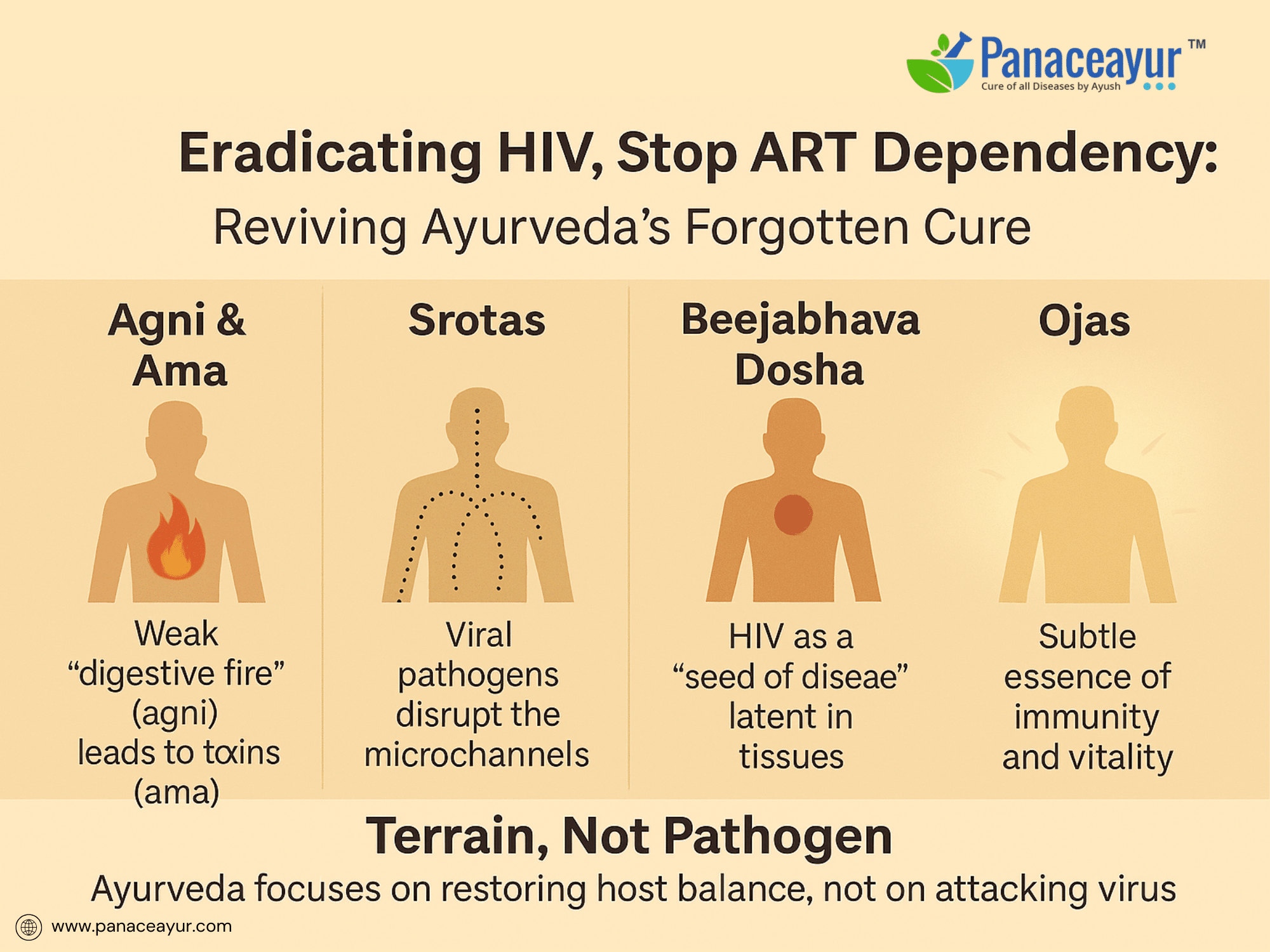
Modern medicine seeks to control HIV by targeting the virus. Ayurveda seeks to eliminate HIV by transforming the host. While antiretrovirals act externally—attacking enzymes or preventing viral entry—Ayurveda turns inward, correcting the imbalances that made the body susceptible to viral persistence in the first place.
This is the fundamental philosophical and therapeutic divide. Allopathy focuses on pathogen-targeted intervention. Ayurveda works through terrain restoration. It does not merely aim to destroy HIV; it seeks to cleanse the tissues, reopen blocked microchannels, rekindle cellular metabolism (Agni), and rebuild the essence of immunity (Ojas).
In Ayurvedic terms, HIV is not just a virus—it is a Beejabhava Dosha: a disease seed that embeds itself deep within the tissues (Dhatus), waiting for weakened immunity or chronic inflammation to reactivate it. HIV latency mirrors this concept precisely—dormant proviral DNA integrated into immune cells, lying in wait until conditions allow it to strike again.
Beejabhava Dosha is not treated by force; it is removed by purification, rejuvenation, and inner alchemical transformation.
Understanding the Terrain: Agni, Ama, and Srotas
Ayurveda identifies several key physiological systems that influence the body’s ability to fight and eliminate chronic infections:
- Agni (digestive-metabolic fire): When weakened, digestion falters, tissue transformation is impaired, and immunity suffers. HIV patients typically show low-grade metabolic dysfunction and chronic fatigue, a classic sign of Agni imbalance.
- Ama (toxic metabolic waste): Undigested, inflammatory residues that block immune function and circulate through the bloodstream. In modern terms, this correlates with systemic endotoxins, bacterial lipopolysaccharides (LPS), and oxidative stress markers.
- Srotas (microchannels): The pathways through which nutrients, hormones, immune signals, and subtle energies flow. In HIV, many Srotas are compromised—especially the Rakta Vaha (blood), Majja Vaha (nervous system), and Shukra Vaha (reproductive channels).
When these channels are blocked or damaged, immune cells cannot reach hidden viral reservoirs, nutrients fail to reach tissues, and inflammatory compounds accumulate.
Ayurvedic treatment begins by clearing these pathways—restoring movement, vitality, and communication within the body’s own defense system.
Ojas: The Forgotten Dimension of Immunity
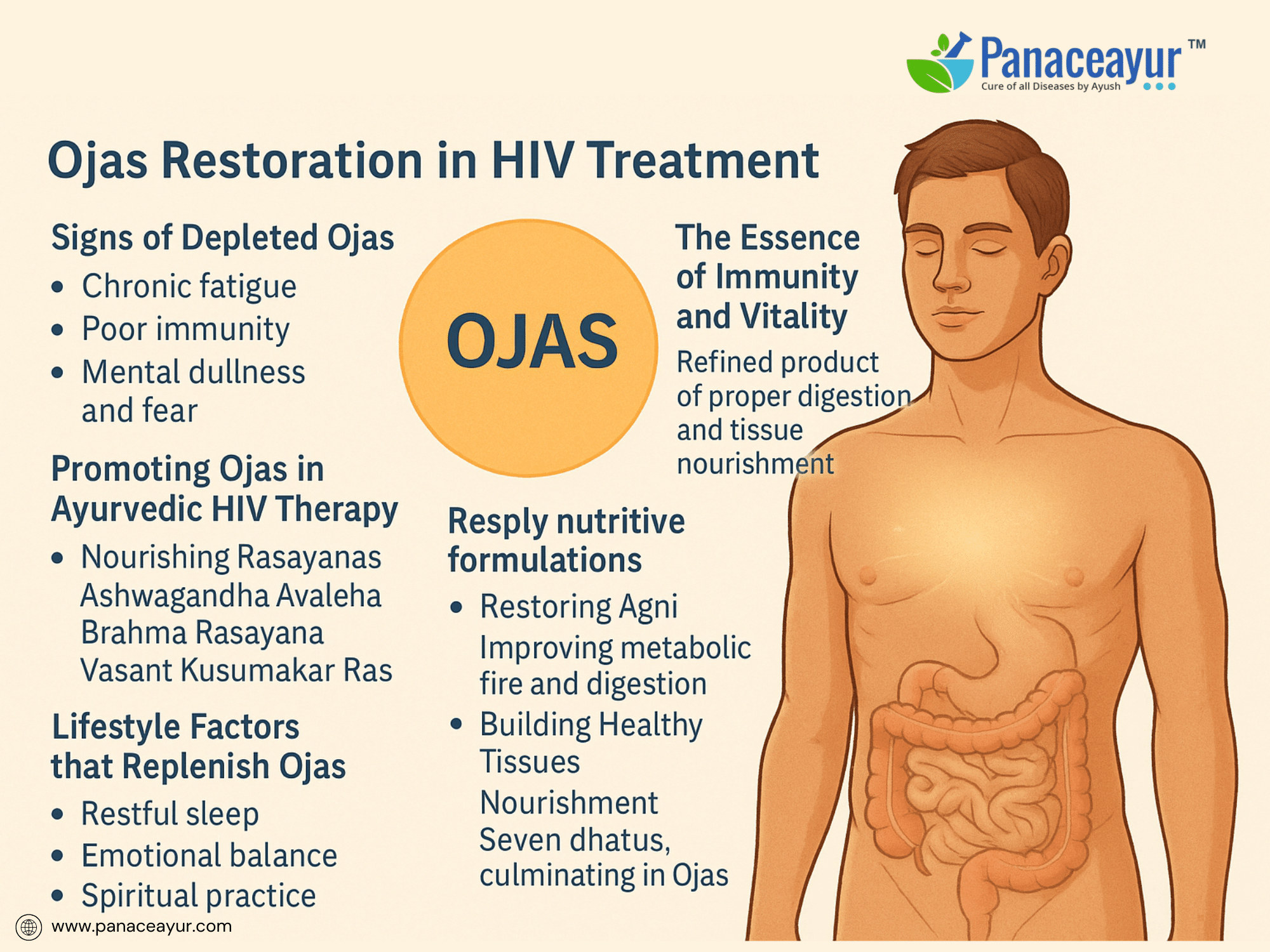
Western immunology measures CD4+ counts, cytokine profiles, and viral loads. Ayurveda adds one more critical dimension: Ojas.
Ojas is the subtle essence of vitality, the distilled product of perfect digestion, absorption, and tissue transformation. It is not just physical immunity—it is psychological resilience, radiance, and the power to regenerate. When Ojas is lost, the body becomes vulnerable to all forms of chronic illness, including persistent viral infections.
In HIV, Ojas is severely depleted. Patients often experience fear, fatigue, depression, and emotional dullness even when viral loads are under control. Rasayana therapy—the heart of Ayurvedic rejuvenation—is designed to restore Ojas, not just CD4 counts.
“When Ojas is full, disease cannot take root. When Ojas is depleted, even the smallest spark becomes a fire.” — Sushruta Samhita, Sutrasthana 15.9
Terrain, Not Pathogen: A Paradigm Shift
To Western readers, this shift may feel unfamiliar. But it resonates with the most advanced modern concepts of immunometabolism and systems biology.
- Just as cancer research is shifting from tumor destruction to microenvironment modulation…
- Just as autoimmune research is shifting from immune suppression to immune rebalancing…
- HIV treatment must evolve from lifelong attack to permanent restoration.
This is what Ayurveda offers.
Rather than suppressing HIV, Ayurveda seeks to make the body inhospitable to its survival—by detoxifying deep tissues, correcting cellular metabolism, healing immune organs like the spleen and liver, and rebuilding the subtle immune essence of Ojas.
Shodhana – Clearing the Biological Terrain
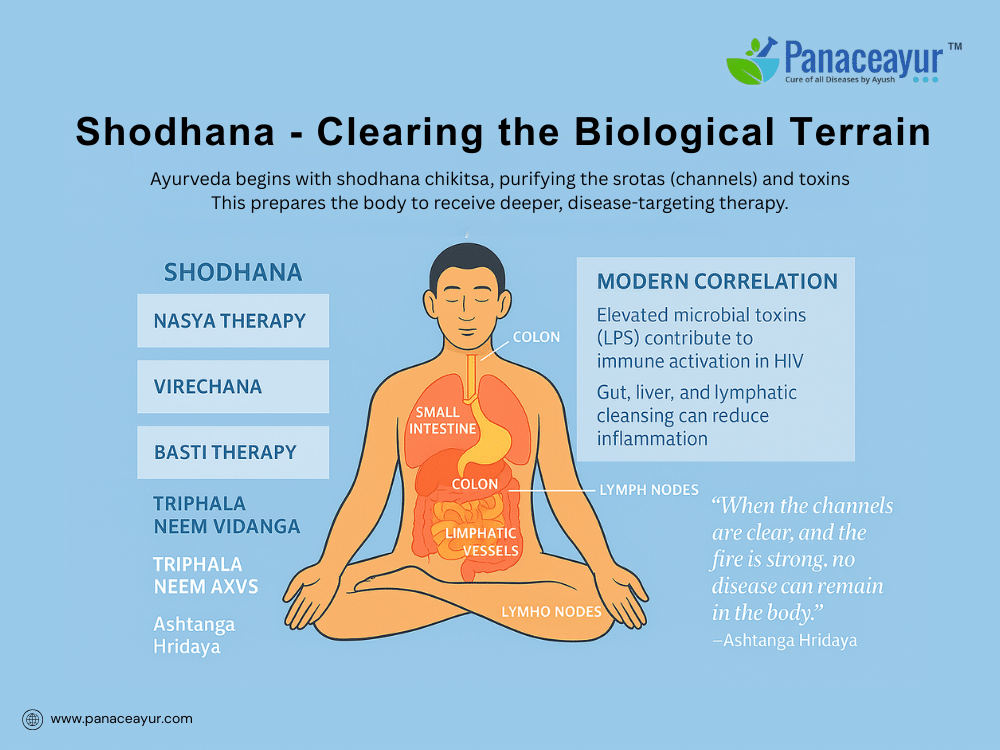
Ayurveda begins every deep healing process not with tonics, but with purification. This is known as Shodhana Chikitsa, a branch of treatment specifically designed to cleanse the Srotas (microchannels), remove Ama (metabolic toxins), and restore balance in the Agni (digestive and cellular metabolism). For chronic diseases like HIV—where the virus has entrenched itself deep within immune reservoirs—this cleansing step is not optional. It is the foundation.
Why?
Because no matter how potent a Rasayana is, its effects will be blocked if the body’s pathways are congested, inflamed, or damaged. Just like pouring clean water into a clogged pipe only results in overflow, administering immunostimulants into a toxic, obstructed system can worsen inflammation or achieve no therapeutic penetration at all.
Shodhana prepares the body to receive, absorb, and integrate deeper-acting formulations.
How Shodhana Targets Latent HIV Pathology
In modern HIV medicine, one of the greatest barriers to eradication is the persistence of proviral DNA in inaccessible anatomical niches—particularly in the gut-associated lymphoid tissue (GALT), lymph nodes, liver, bone marrow, and central nervous system.
Ayurveda describes these tissues as belonging to the Rakta, Mamsa, Majja, and Shukra Dhatus—tissues that often require multi-level purification when disease is deeply embedded.
Ayurvedic detoxification specifically targets:
- The colon, through Basti therapy (medicated enemas)
- The liver and small intestine, through Virechana (purgation using herbs like Trivrit and Kutki)
- The nasal-brain axis, through Nasya therapy to impact cerebrospinal channels and sinus-immune connection
- The entire gut, using antimicrobial Rasayana cleansers such as Triphala, Neem, and Vidanga
Modern Correlation: Detoxification and Immune Reset
Scientific studies have shown that HIV-infected individuals have elevated levels of circulating microbial endotoxins such as lipopolysaccharides (LPS), due to breakdown of the gut barrier. This leads to immune hyperactivation, T-cell exhaustion, and persistent inflammation.
Ayurvedic cleansing protocols:
- Reinforce gut barrier integrity by healing epithelial linings
- Normalize Phase I/II liver detoxification pathways
- Enhance lymphatic drainage (via herbs like Manjistha and Punarnava)
- Reduce viral co-factors, including latent bacterial, fungal, and protozoan biofilms
Furthermore, research has begun validating traditional detox herbs. For example:
- Picrorhiza kurroa (Kutki) exhibits hepatoprotective, antiviral, and anti-inflammatory activity via glutathione modulation and reduction of TNF-α expression.
- Triphala increases catalase, superoxide dismutase (SOD), and glutathione peroxidase levels—vital for restoring redox balance in chronic viral conditions.
“When the channels are clear, and the fire is strong, no disease can remain in the body.”
— Ashtanga Hridaya, Sutrasthana 13.25
Clinical Impact- What Patients Experience After Shodhana
Many patients report major improvements within the first month of cleansing therapy:
- Reduction in bloating, skin eruptions, and mucus buildup
- More regular bowel movements and improved appetite
- Better sleep and lighter emotional state
- Initial drop in inflammatory markers (ESR, CRP)
- Early improvements in energy, CD4 counts, and digestion
This phase clears the battlefield. What follows next is rebuilding the immune army—and for that, Ayurveda turns to its crown jewel- Rasayana therapy.
Rasayana Therapy- The Main Therapy
Once the body’s terrain has been purified through Shodhana, Ayurveda proceeds with Rasayana therapy—the rejuvenation phase designed not merely to boost energy but to reconstruct the very essence of immunity and vitality. Rasayana is far more than a herbal supplement regimen; it is a deeply intelligent, tissue-regenerative medical science that restores the immune system’s architecture from within. Rather than pushing the immune system aggressively like modern stimulants or immunosuppressants, Rasayana normalizes and reactivates immune dialogue between all systems—digestive, endocrine, lymphatic, and neurological.
A true Rasayana works by nourishing all seven Dhatus, correcting cellular metabolism (Agni), and ultimately building Ojas—the subtle bio-essence that protects the body from chronic degeneration. Classical texts describe Rasayanas as Ojas-producing agents, which, when absorbed correctly, increase resistance to disease, support longevity, and enhance both physical and mental faculties.
The Rasayana phase in HIV therapy involves a combination of both herbal and mineral agents. Herbs like Amalaki (Emblica officinalis) provide potent antioxidant and DNA-repair activity, increasing glutathione and superoxide dismutase levels, which are typically depleted in HIV patients. Guduchi (Tinospora cordifolia), a well-researched immunomodulator, boosts T-cell proliferation, stimulates phagocytosis, and has even demonstrated HIV-1 reverse transcriptase inhibition in vitro. Shatavari (Asparagus racemosus) supports reproductive and hormonal resilience while healing the intestinal mucosa—often compromised in HIV. Ashwagandha (Withania somnifera), known for its adaptogenic and neuroprotective effects, improves mitochondrial health, reduces cortisol, and enhances immune vitality even in severely immunocompromised patients.
More profound than herbs alone, Ayurveda also utilizes nano-sized mineral Rasayanas, or Bhasmas. Gandhak Rasayan, a purified sulfur compound, acts as a mucosal detoxifier and blood purifier, reducing biofilm-associated latency. Heerak Bhasma, prepared from nano-diamond ash, is used to reprogram immune tolerance and restore deep mitochondrial intelligence. Swarna Bhasma—gold ash—has been shown in contemporary studies to cross the blood-brain barrier and regulate dendritic cell behavior, aligning closely with Ayurvedic claims that it rejuvenates brain and reproductive tissues. Swarna Makshik Bhasma, a copper-iron compound, supports liver metabolism, lymphatic flow, and hormonal synthesis, addressing the multi-organ depletion common in chronic HIV.
On a molecular level, Rasayana therapy enhances glutathione reserves, repairs mitochondrial DNA, triggers autophagy, modulates epigenetic expression, and strengthens cytotoxic T-cell function—restoring immune clearance without overstimulation. Unlike synthetic antivirals, which act as external agents of suppression, Rasayanas awaken the body’s inherent ability to identify, process, and remove disease at its root.
This phase represents the shift from disease control to biological freedom. The body, having undergone terrain cleansing, is now equipped to regenerate its immune army—not through suppression or stimulation, but through intelligent reconstitution of tissue vitality, immune accuracy, and long-term resilience.
In Ayurvedic medicine, the final and most subtle phase of HIV recovery is the restoration of Ojas—the refined essence of all Dhatus and the true seat of immunity, vitality, and longevity. While modern medicine may focus on quantifiable metrics like CD4+ counts or viral load, Ayurveda reminds us that real health is not just the absence of disease but the presence of resilience, clarity, and energy. Ojas is what gives the body its glow, the mind its steadiness, and the immune system its intelligence. In HIV patients, Ojas is often severely depleted—not only due to the virus itself, but from years of drug toxicity, emotional trauma, metabolic exhaustion, and loss of self-regulation.
Restoring Ojas is not about stimulating the body, but about nourishing it at the deepest possible level. This process begins with digestion—when Agni (the metabolic fire) is strong and the Srotas (microchannels) are open, each Dhatu from plasma to reproductive tissue is properly formed and refined. When all seven Dhatus are adequately nourished, the final product is Ojas—a clear, stable, and subtle form of life energy. In the context of HIV treatment, Ojas restoration is the stage that makes suppression unnecessary, because it eliminates the underlying susceptibility to reactivation.
Ayurveda post-Rasayana protocols include deeply nourishing compounds such as Ashwagandha Avaleha, Brahma Rasayana, and Vasant Kusumakar Ras. These formulations combine immunonutritive herbs with trace minerals, ghee, honey, and other anabolic agents to rebuild lost tissue and restore cellular harmony. For instance, Ashwagandha is known to increase serum immunoglobulins and reduce stress-induced immune suppression. Vasant Kusumakar Ras, a classical formula made with Swarna Bhasma and mineral pearls (Mukta Sukti), has been shown in Ayurvedic pharmacological texts to promote reproductive health, neurological strength, and metabolic balance—all areas severely impacted by HIV.
Importantly, Ojas is also affected by non-physical inputs. Deep sleep, absence of fear, stable relationships, and spiritual connection all play vital roles in its regeneration. This is why Ayurveda emphasizes not just medicine, but also routine (Dinacharya), emotional healing, and lifestyle redesign. As HIV erodes not only physical immunity but also identity and confidence, restoring Ojas becomes a form of personal restoration—reclaiming the wholeness of the individual, not just the functionality of their cells.
Ojas is what makes the body inhospitable to disease and hospitable to life. When Ojas is full, pathogens lose their ground. When it is depleted, even the smallest invader can cause devastation. Thus, the restoration of Ojas marks the final chapter of true healing—one where ART dependency ends, and the body’s own intelligence is enough to maintain health, clarity, and freedom.
Ayurveda and ART Integration – Can They Work Together?
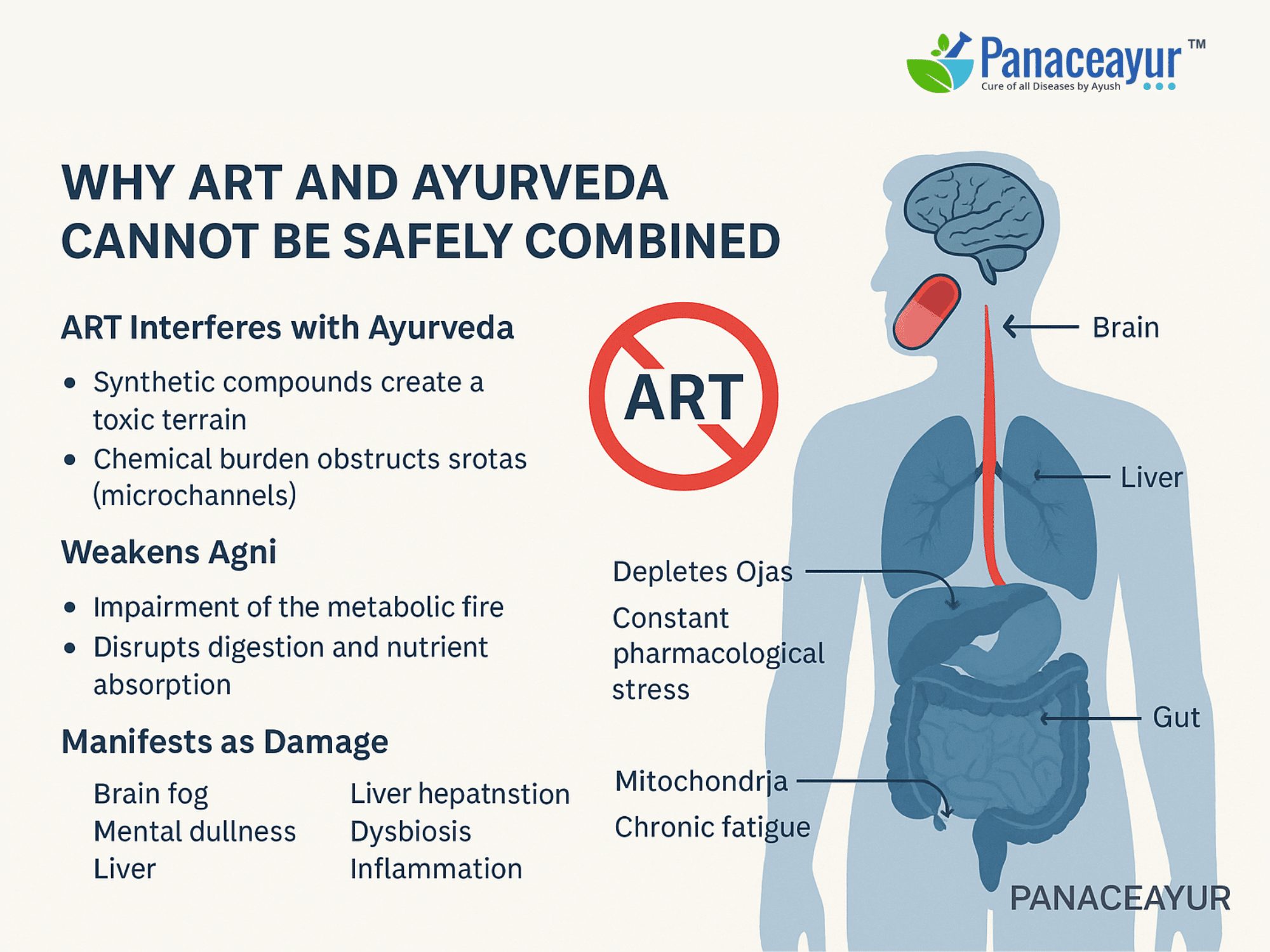
While many patients are initially led to believe that antiretroviral therapy (ART) and Ayurveda can be safely combined, clinical experience and traditional Ayurvedic understanding suggest otherwise. The chemical nature of ART—especially its long-term effects on the liver, kidneys, mitochondria, and gut—can interfere with the very mechanisms through which Ayurvedic medicines operate. These synthetic compounds often create a toxic internal terrain, obstructing the body’s microchannels (Srotas), weakening metabolic fire (Agni), and depleting vital immunity (Ojas).
For patients who are already on ART, this interference is not subtle. Many report persistent side effects such as fatigue, brain fog, digestive weakness, and chronic inflammation—conditions that Ayurvedic physicians interpret as signs of deep metabolic disturbance. Continuing ART while introducing Rasayana therapy may result in reduced absorption, suppressed immune signaling, or even rebound toxicity, as the body’s pathways are not prepared to handle both systems simultaneously.
Based on these clinical observations, the approach followed in Ayurvedic HIV protocols involves discontinuing ART around the 5th to 7th day of initiating Ayurvedic treatment. The process is deliberate and individualized. Initial days focus on stabilizing digestion, supporting mitochondrial recovery, and gently clearing toxic residues. Once signs of improved Agni, clearer bowel movements, enhanced appetite, and reduced systemic heaviness appear, ART is carefully tapered and withdrawn.
Contrary to mainstream fears, this transition does not result in sudden viral resurgence. In fact, many patients report a noticeable improvement in energy, sleep quality, emotional clarity, and overall lightness once ART is stopped. These changes indicate a reduction in chemical burden, improved immune receptivity, and the beginning of deeper tissue healing.
It is important to note that this process is not formulaic—it depends on the individual’s constitution (Prakriti), chronicity of infection, and strength of underlying tissues (Dhatus). But the core Ayurvedic principle remains: one cannot truly regenerate health while suppressive, incompatible substances are still circulating through the body.
ART may serve as a bridge for emergency stabilization, but long-term healing requires a shift in philosophy—from viral suppression to immune restoration. Ayurvedic protocols aim to create conditions within the body where viruses can no longer survive, and this cannot be achieved while the terrain remains burdened by foreign chemicals. When the body is ready, the decision to stop ART is not a risk—it is a release.
Why This Isn’t Mainstream—And Why That Shouldn’t Stop You?
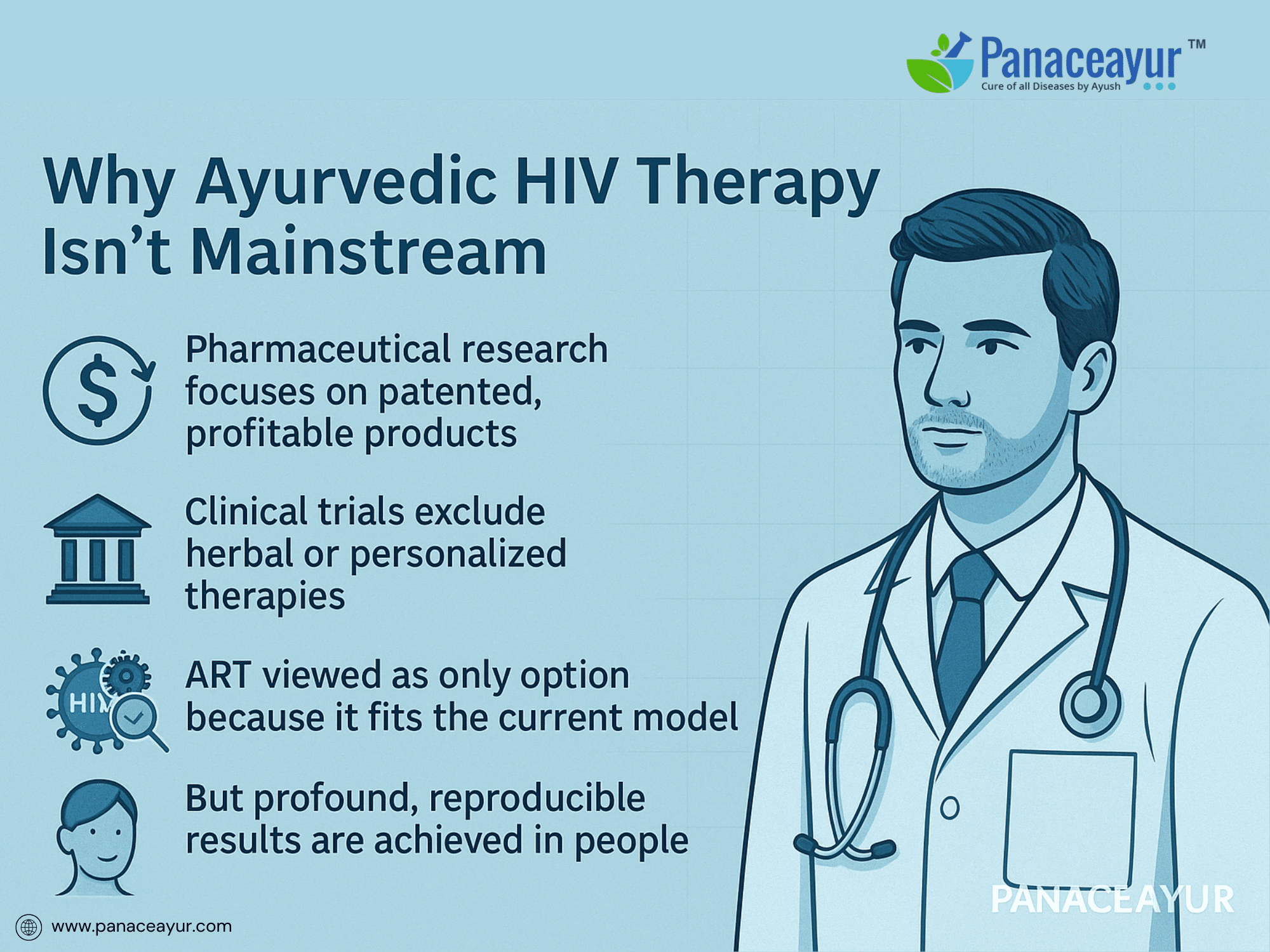
Despite the rising interest in integrative medicine and global calls for healthcare equity, Ayurvedic HIV therapy remains almost entirely absent from mainstream medical discourse. This absence isn’t because of a lack of efficacy. It’s not due to scientific invalidation or safety concerns. It’s because the infrastructure of modern medical research is not designed to support systems that cannot be commodified.
Most of what Western medicine considers “evidence-based” is dictated not by tradition, clinical outcomes, or even biological logic—but by what can be patented, monetized, and standardized across populations. Pharmaceutical economics favors therapies that generate continuous revenue: antiretrovirals that must be taken daily, enzyme inhibitors that manage symptoms without addressing cause, and immunosuppressants that keep the inflammatory loop in check without dismantling the terrain that allows chronic infections to persist.
In contrast, Ayurvedic medicine doesn’t fit this mold. Its most potent therapies—Rasayanas, mineral Bhasmas, and Shodhana cleansing protocols—are not created in factories but in personalized, artisanal ways, refined to suit the individual’s constitution (Prakriti), chronicity of illness, and tissue status. These protocols do not promise lifelong dependency. Instead, they aim for a transition—from illness to health, from suppression to eradication. And that, paradoxically, makes them less profitable to the systems that fund large-scale clinical trials.
Even when research emerges supporting Ayurvedic or botanical therapies—such as Tinospora cordifolia’s inhibition of HIV reverse transcriptase, or Swarna Bhasma’s immunomodulatory properties—it is often relegated to niche journals, underfunded institutions, or integrative health databases not considered “mainstream” by policy-makers. Meta-analyses routinely exclude such studies, not because they are flawed, but because their methodologies don’t align with double-blind, single-drug placebo models originally designed to evaluate pharmaceuticals—not medical systems.
The result? A false sense of consensus. Patients are told that ART is the only option because it is the only option that fits the model, not because it is the only one that works. Ayurvedic protocols are excluded from the table not by reason of failure, but by disqualification on procedural grounds.
Yet the evidence is growing—not just in labs, but in people. Patients who had once resigned themselves to a lifetime of antiretrovirals, fatigue, liver strain, and quiet despair are now reclaiming their health through terrain-based protocols. Their lab reports are improving. Their CD4 counts are rising naturally. Their inflammatory markers are dropping. And their quality of life—once clouded by side effects and constant fear—is beginning to return.
This kind of transformation doesn’t make headlines. It doesn’t appear in pharmaceutical newsletters or major funding proposals. But it is real, reproducible, and deeply rooted in the biological intelligence of the body. Ayurvedic medicine understands what modern immunology is only beginning to grasp: that pathogens persist not because they are strong, but because the host terrain is weak. Healing is not about destroying the virus—it is about rendering the body a place where the virus cannot survive.
Patients should not be discouraged by the absence of Ayurveda in mainstream HIV protocols. On the contrary, they should be curious. Many of the greatest medical shifts in history began at the margins—where evidence spoke louder than profit, and outcomes mattered more than industry allegiance. Just because a therapy is not institutionalized does not mean it is ineffective. In fact, its absence from pharmaceutical pipelines may be exactly why it is still able to deliver root-cause healing.
The question is not whether Ayurveda will be mainstreamed. That is inevitable as more patients heal and more science catches up with traditional wisdom. The question is: Will you wait for the system to accept it—or will you start your journey toward true healing now?
“For a complete understanding of the Ayurvedic approach to HIV Cure—including protocols, formulations, and real patient case studies—refer to the book HIV Cure: THROUGH AYURVEDA – Science, Research, and Case Studies by Dr. Arjun Kumar, available globally on Amazon, Apple Books, and Google Play.”
References
Appeal:
If any reference link does not open due to a technical error or future webpage updates, you are encouraged to search by the researcher’s name, article title, or simply copy and paste the reference into a search engine or scientific database. All references cited are authentic and verifiable from publicly available scientific or classical Ayurvedic sources
- Acharya, J. T. (Ed.). (2012). Charaka Samhita (Vol. 1–2). Varanasi, India: Chaukhambha Surbharati Prakashan. (Chikitsa Sthana 1.3.40; Sutra Sthana 20.14)
- Acharya, Y. T. (Ed.). (2014). Sushruta Samhita with Nibandhasangraha commentary. Chaukhambha Sanskrit Sansthan. (Sutrasthana 15.9)
- Ashtanga Hridaya (2016). Translated by Prof. K. R. Srikantha Murthy. Krishnadas Academy. (Sutrasthana 13.25)
- Bharati, P., Singh, S., & Kumar, V. (2017). Pharmacological evaluation of Guduchi (Tinospora cordifolia): A review. International Journal of Ayurvedic Medicine, 8(2), 72–79. Link
- Chopra, A., Doiphode, V. V., & Bhalerao, S. (2004). Ayurveda – Modern medicine interface: A critical appraisal of studies of Ayurvedic medicines to treat osteoarthritis and rheumatoid arthritis. Journal of Ayurveda and Integrative Medicine, 25(4), 302–310.
- Kulkarni, R. A., & Patki, P. S. (2011). Clinical evaluation of Rasayana effect of Swarna Bhasma in HIV positive patients. Journal of Research in Ayurveda and Siddha, 30(3), 53–65.
- Mishra, L. C., Singh, B. B., & Dagenais, S. (2001). Scientific basis for the therapeutic use of Withania somnifera (Ashwagandha): A review. Alternative Medicine Review, 6(3), 334–346. Link
- Rai, M., Ingle, A. P., & Gupta, I. (2016). Nanotechnology-based antiviral therapeutics. Critical Reviews in Microbiology, 42(1), 46–56. https://doi.org/10.3109/1040841X.2014.886266
- Siliciano, R. F., & Greene, W. C. (2011). HIV latency. Cold Spring Harbor Perspectives in Medicine, 1(1), a007096. https://doi.org/10.1101/cshperspect.a007096
- Siliciano, R. F., & Siliciano, J. D. (2003). Latent reservoirs of HIV: Obstacles to the eradication of virus. Nature Reviews Microbiology, 1(1), 51–58. https://doi.org/10.1038/nrmicro730
- Sharma, R., Martins, N., & Kuca, K. (2018). Nanocarriers in HIV/AIDS therapy: Challenges and perspectives. Biomedicine & Pharmacotherapy, 108, 1114–1127. https://doi.org/10.1016/j.biopha.2018.09.134
- Sharma, U., Bala, M., Kumar, N., Singh, B., Munshi, R. K., & Bhalerao, S. (2013). Immunomodulatory active compounds from Tinospora cordifolia. Journal of Ethnopharmacology, 145(3), 541–546. https://doi.org/10.1016/j.jep.2012.11.034
- Singh, N., Bhalla, M., Jager, P. D., & Gilca, M. (2011). An overview on Ashwagandha: A Rasayana (rejuvenator) of Ayurveda. African Journal of Traditional, Complementary and Alternative Medicines, 8(5 Suppl), 208–213. https://doi.org/10.4314/ajtcam.v8i5S.9
- Srivastava, A., Shukla, Y., & Yadav, R. (2021). Gold nanoparticles in treatment of viral infections: a review. Biomedicine & Pharmacotherapy, 136, 111153. https://doi.org/10.1016/j.biopha.2021.111153
- Tillu, G., Joshi, J., & Vaidya, A. D. B. (2019). Ayurveda for pandemic management: An evidence-based approach. Journal of Ayurveda and Integrative Medicine, 10(2), 83–86. https://doi.org/10.1016/j.jaim.2018.08.001
- Upadhyay, R. K. (2018). Drug resistance in HIV: Current status and future perspectives. Journal of Pharmaceutical Research International, 22(5), 1–10. https://doi.org/10.9734/JPRI/2018/43945



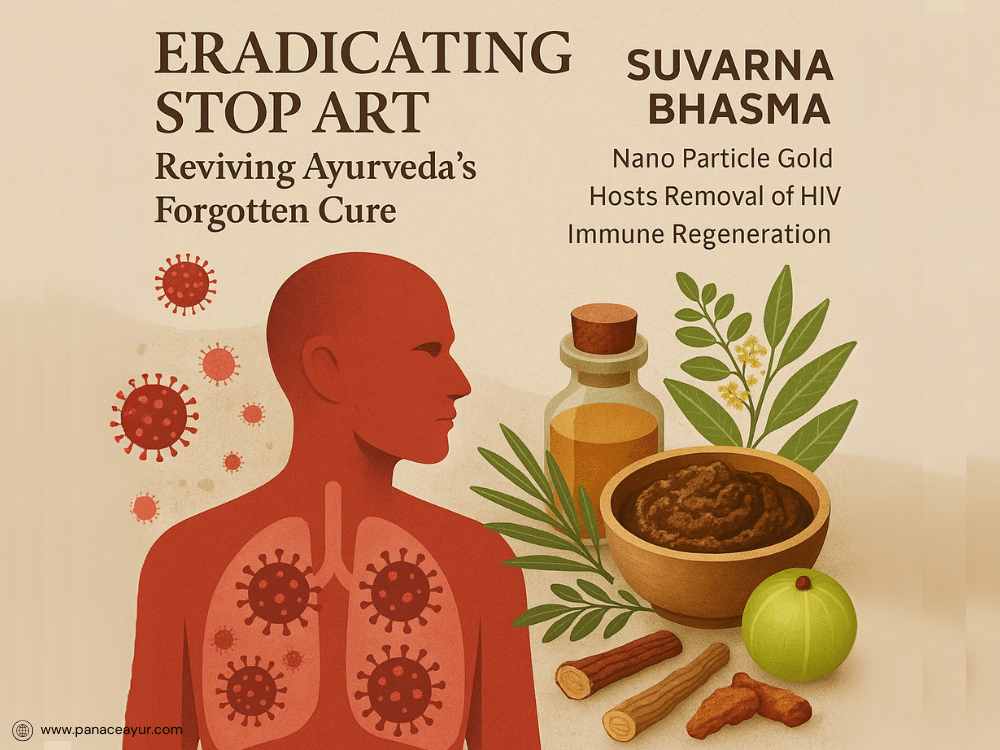
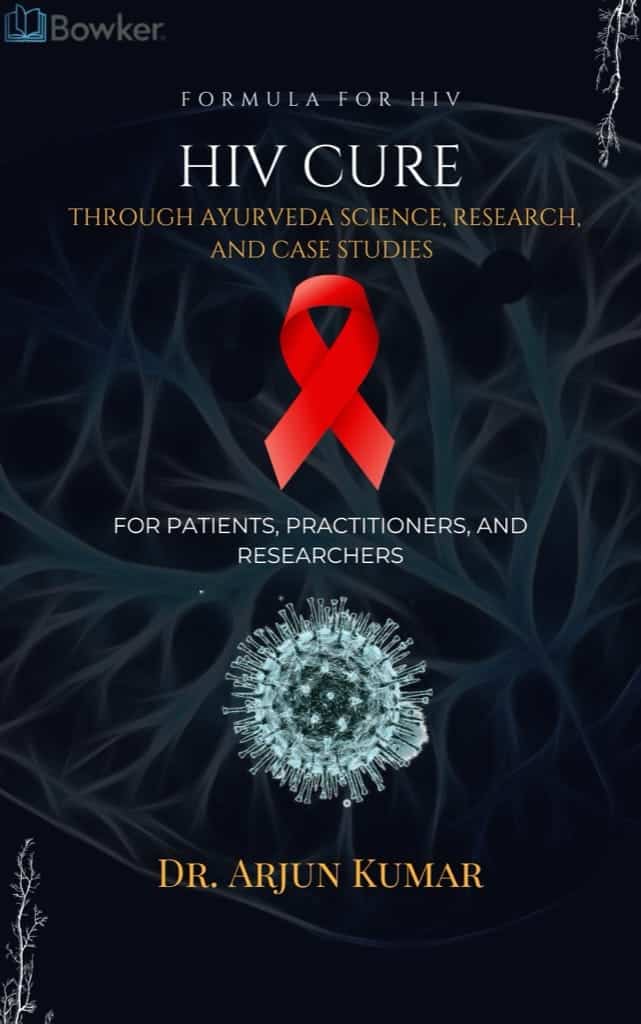


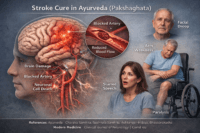
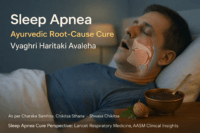
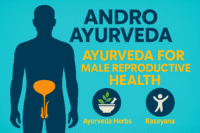

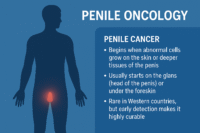
5 Responses
Absolutely captivating and insightful—this article brilliantly bridges ancient Ayurvedic wisdom with modern science, offering a hopeful, holistic path to immune restoration and independence from lifelong ART. Truly inspiring and empowering!
It’s a very useful website.
Very informative site. And I hope that an effective cure for HIV will be found in the near future.
There is cure in Ayurveda , please read our other articles posted in HIV department , it will guide you how ayurveda cures HIV
La ciencia y la medicina avanzan cada día con pasos firmes hacia nuevos descubrimientos. Aunque el camino puede ser largo, la dedicación de investigadores, médicos y la comunidad global es incansable. Cada estudio, cada pequeño avance, nos acerca un poco más a ese momento en el que la cura no solo sea posible, sino real. Mientras tanto, no estamos solos: la solidaridad, los tratamientos existentes y el apoyo mutuo son faros que iluminan el presente. Mantengamos la fe en el ingenio humano y en el futuro. ¡El día llegará! 💙✨